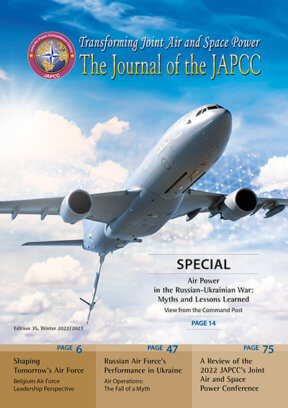Introduction
Damage and destruction of Cultural Property (CP) is a regrettable feature of warfare throughout history. The reasons range from the incidental, such as careless indifference, collateral damage coincident to legitimate acts, or lack of knowledge of CP, to the intentional, such as indiscriminate use of wide-area effects weapons or the intentional erasure of cultural sites to undermine an adversary’s resolve. Even when conducted under the banner of military necessity, the damage is often irreversible. Destruction, damage, or misappropriation of CP as an attack on a sector of society is an affront to the laws of war and can have far-reaching consequences, acting as a driver of conflict.
Many will know of the 2014 film ‘The Monuments Men’, based on the true story of a team who sought to preserve priceless pieces of art from destruction or theft during the Second World War. Whilst their perseverance will live on in history, the value placed on CP in conflict is not limited to artworks and paintings. CP includes ‘the tangible, visual and totemic cultural expression of a community, a society, a nation and, ultimately, of humankind’.1 It is thus an expression of cultural identity and community cohesion.
Protecting CP during armed conflict is a legally mandated military task, and is applicable to all phases of military activities and operations. Cultural Property Protection (CPP) requirements fall under the framework of the International Law of Armed Conflict (LOAC). Specific CPP obligations are embedded in the 1954 Hague Convention for the Protection of Cultural Property in the event of armed conflict (the ‘Hague Convention’); its two additional protocols (from 1954 and 1999) clarify and complement the original treaty.
In international law, CP is defined as ‘movable or immovable property of great importance to the cultural heritage of every people, such as monuments of architecture, art, or history…buildings whose main and effective purpose is to preserve or exhibit the movable cultural property…and centres containing a large amount of cultural property’.2
The aforementioned laws require ‘the safeguarding of and respect for such property’.3 This places international legal obligations on military forces. Failure to abide by those laws can lead to the prosecution of both the perpetrators and their commanders.
In practice, CPP describes all activities dedicated to minimizing damage to CP in an armed conflict. These activities vary from ensuring CP sites are on no-strike lists, avoided during manoeuvres, and protected from damage and theft in occupied areas. Protection of CP can preserve and enhance military reputation both locally and globally, maintain an ability to influence those amongst which military forces operate, and also contribute to force protection and freedom of manoeuvre.4,5 In contrast, carelessness or intentional destruction delegitimizes forces and can lead to the loss of public or host nation support. Within NATO, CP is considered more broadly to include cultural objects and all places of worship. NATO thus defines CP as moveable or immovable property that enjoys recognition and protection under customary international law and, as applicable, treaty law.6
The wider international community should be assured that NATO, along with its allies and partners and aided governmental and non-governmental actors, has procedures in place for the respect and consideration of CPP at all stages of a conflict, should such an occasion arise. This paper serves to address the importance of minimizing collateral effects on CP during times of conflict and the strategic effects that ignoring culturally sensitive property can bring to bear. It will include a precis of targeting procedure regarding CP, examples of military units engaged in CPP and how those units bring CPP into exercises, as well as recommendations for the future.
Targeting Procedures and CPP
Precision weapons have revolutionized modern warfare, but are beyond many combatants’ technical capabilities, and, when present, are always in limited supply. This results in significant risks to CP. If CP sites are not considered in the operational planning processes, the potential for accidental damage increases significantly. Collateral damage to CP may be the result of wilful disregard (legitimate or illegitimate) or error, but in either case can yield a propaganda opportunity for the adversary. Damage to CP, whether lawful or not, can affect reputation, the ability to influence communities within the area of operations, and may lead to reprisal attacks that further escalate tensions, spread violence, and affect force protection.
NATO conducts targeting through a set of repeatable and measurable procedures that allow for the lawful targeting of an adversary. Should NATO (or any combatant) not act lawfully, it may be brought before the International Criminal Court according to established procedures. All sides must be accountable for their actions, as the means to inflict damage or destruction carries with it great responsibility; NATO conducts its actions transparently.
Conflicts involve committing acts where people may die and infrastructure may be destroyed; it should not be surprising that it is legal to do so under the LOAC. Military forces would not be able to operate without the legal means to carry out their tasks and missions. As such, the LOAC is shaped by the principles of necessity, distinction, humanity, and proportionality no less than any other aspect of the targeting methodology. The consideration of CP during the targeting process is both an international legal and moral obligation, and a practical necessity. Apart from the No-Strike List and the Restricted Target List, CP should also be included in the Collateral Damage Estimation (CDE), in which targeteers, lawyers, commanders, and others assess the magnitude of expected collateral damage for planned strikes. Contrary to common belief, CDE procedures exist for the protection of civilian personnel and infrastructure. A rigorous target development process is essential to enable commanders to make informed determinations of necessity, proportionality, and collateral damage risk when prosecuting targets on or near CP.
NATO not only acts transparently and has good measures to avoid unnecessary damage, but it goes further to liaise with specialized organizations that focus on collateral concerns that could cause unnecessary pain, suffering, or loss of support from a host nation. Examples may include liaising with local civilian organizations responsible for safeguarding CP, deconfliction with Non-Governmental Organizations (NGOs) conducting humanitarian flights into a conflict zone, or, as this article will examine next, with organizations such as the Blue Shield, an NGO specialized in CPP.
Extant CPP Actors
UK Reserve Forces CPP Unit
The United Kingdom (UK) military established a CPP unit in 2018, comprised of specialized reservists with expertise in CPP, such as building surveying and conservation, artefact conservation, cultural heritage, archaeology, etc. Their role is to deliver the CPP capability and provide support to exercises, targeting, and operational planning, training for the armed forces, advice to commanders and staffs, and coordination with civilian authorities responsible for CP safeguarding of in the event of an armed conflict.7
This unit is embedded in the 77th Brigade’s Outreach Group that also enables operations by facilitating civil-military cooperation between the force, non-military actors, and the civil environment. It also acts as the defence coordinating authority for support to the delivery of human security operational outputs and contributes to cross-government stabilization and reconstruction efforts.8
US 10th Mountain Division (Light Infantry)
Since September 2016, the United States (US) has also sought to form partnerships with CPP actors. Specifically, the 10th Mountain Division has combined with the Cultural Resources Team (CRT) at Fort Drum, New York, to enhance training to include CP aspects. For example, ‘when soldiers reported that Iraqi insurgents were using headstones as firing points, the CRT constructed culturally reminiscent replica cemeteries and added them to urban sprawl and urban terrain training sites on Fort Drum so that dealing with such scenarios could be practiced. And, after the global news media featured reports of damage to the ancient city of Babylon by US and Polish forces in 2004, the CRT constructed mock ruins in the training areas to offer field training opportunities to identify, avoid, and respect ancient places as well as sites regarded as sacred by indigenous peoples during the course of military operations’.9
CPP capability further developed through the US Army Civil Affairs & Psychological Operations Command (Airborne), to increase knowledge and understanding in protecting and preserving CP in armed conflict. The 10th Mountain Division has developed a training programme for all Army Reserve Civil Affairs soldiers (Course 38G/6V Heritage and Preservation) that provides support to areas including Joint Intelligence Preparation of the Operational Environment, as well as training on the practicalities of CPP in a conflict zone with hazards, forensic documentation, and handling of damaged materials.
Blue Shield International
Blue Shield International is ‘committed to the protection of the world’s cultural property, and is concerned with protecting the tangible and intangible cultural and natural heritage in the event of armed conflict, natural- or human-made disaster’.10 Why should a military organization liaise with Blue Shield or other similar NGOs? Why not just avoid cultural sites?
As you would expect of a modern military force, NATO identifies any aspects within an operational area that might be controversial, sensitive, or protected. Local knowledge and advice from experts in the field is essential. The advice provided by Blue Shield may avoid second or third-order effects, such as the loss of public support. Regardless of the legitimacy of strikes under LOAC, reprisals from the local population for damaged or destroyed CP have the potential to foment protests and civil unrest. Furthermore, the damage and unrest are easily exploited by adversary media and could harm Alliance’s reputation and affect mission success. Just because you can, does not necessarily mean you should.
In the past, Blue Shield was responsible for advising and training military personnel in CPP aspects, such as evacuation, refugee resettlement, and damage assessment. In tactical training scenarios, Blue Shield hires local actors to portray citizens with information, in varying forms of distress, and highlight that cultural heritage preservation is actually about protecting the domestic culture and people.
Protecting Objects of Cultural Significance
NATO goes to great lengths to identify all locations of CP wherever it operates. This includes places of worship, e.g. mosques and churches, monuments of architecture, art, or history, and buildings whose main purpose is to preserve or exhibit movable CP. It is also no secret that NATO has policies in place to protect such locations of cultural significance as a force multiplier. Regrettably, organized crime and other combatants have exploited these policies by hiding in and operating in the vicinity of CP with the expectation that NATO would not target them.
In general, targeting CP is prohibited.11 However, under LOAC, there is an exception for military necessity, wherein such locations may be targeted under circumstances that suspend their protective status. For example, CP may be targeted if the enemy occupies it, thereby making it a legitimate military target. The target then may be struck if there is ‘no feasible alternative to obtaining a similar military advantage’ and if at the time of the attack the destruction, capture, or neutralization offers ‘a definite military advantage’.12
NATO boards target through a process that ensures all aspects of a potential strike are valid and accountable from a legal, strategic, political, and intelligence perspective. In such forums, all significant aspects of any potential target are highlighted either by the host nation representatives or experts on gender, CP, STRATCOM, etc. In this best available – yet still imperfect – way, commanders make the delicate decisions balancing operational necessity and the imperative to preserve the lives of friendly forces. After all, we cannot put the value of property above that of human life. That said, if there is an option to preserve both, then knowing the cultural significance will aid commanders in their decision-making process.
In their book, ‘Just War, Ethics in Modern Warfare’, the authors explain that ‘we must not do things, however legitimate in themselves, if in our honest and considered opinion the good they achieve is likely to be outweighed by the harm they inflict on those who ought not to be harmed’.13 Thus, targeting a legitimate military objective should prohibit causing disproportionate damage to CP; the benefit of the attack must outweigh the loss.
Proportionality is one of the most subjective and unclear criteria to prove from a legal perspective. There are two aspects, namely: the hard-to-identify second-order effects and the unclear amount of gain from a military perspective in destroying an asset sheltered within a protected space. Proportionality does not mean that a threat can be ignored. If destroying it prematurely ends a conflict or potentially saves lives, is it then justified? There will always be adverse media highlighting controversial decisions made in conflict, but the transparent processes described helps ensure due diligence when making difficult decisions.
CP in NATO Exercises
How do we ensure the continuation of due regard towards CP in NATO? NATO’s Joint Warfare Centre (JWC) is the primary unit for exercising and certifying the Alliance’s capability to conduct all aspects of offensive and defensive operations. In recent years, the JWC modified training scenarios to include gender and cultural aspects to create more challenging cultural dilemmas for exercise participants.
The inclusion of CPP and gender have since been taken forward in major NATO exercises. Exercise Steadfast Jackal 2021 witnessed modern, real-world dilemmas relating to historical tribal cross-border conflicts, in austere conditions, outside NATO territory, and included matriarchal gender injects and protection of historical tribal locations for consideration within the targeting process. The exercise was well received, notably for leading the training audience outside of its comfort zone compared to previous large-scale exercises that treated limited resources as the primary challenge. Within this scenario, key leader engagement was paramount in identifying those cultural and strategic dilemmas that might otherwise have rendered the Alliance’s presence abroad untenable.
Recommendations
Commanders at every level should seriously consider all aspects of CPP, and acknowledge the second and third-order effects that collateral damage to CP might bring. Utilizing expert advice in areas requiring unique perspectives would extensively aid and enhance the decision-making process.
Headquarters and commanders should embrace NGOs and invite them to contribute to the creation of detailed databases with locations of cultural significance. It is also in the interests of any civil organization vested in protecting CP to engage with the military to ensure it is protected. This is a symbiotic relationship for the greater good.
Conclusion
Numerous initiatives over recent years have enhanced the means by which NATO allies conduct themselves in conflict. Quite rightly, all organizations should strive to test and adjust their procedures and be the best at their professions. As we evolve with technological advances, so too we must perpetually review our processes to ensure we have all the information required to make informed decisions.
Recognizing CPP as a force multiplier highlights the value of avoiding potential strategic complications due to ill-advised tactical actions during conflict. For legal and moral reasons combatants must do everything possible to protect cultural property.











